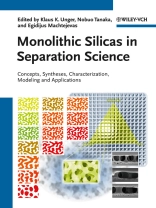Edited by the experts and pioneers in the field, this is the first monograph to cover the topic, containing the must-have information hitherto only scattered among journals.
Clearly divided into sections on preparation, characterization and modeling, and applications, this is essential reading for chemists, chromatographers, analytical chemists, biochemists and biologists.
Clearly divided into sections on preparation, characterization and modeling, and applications, this is essential reading for chemists, chromatographers, analytical chemists, biochemists and biologists.
Table of Content
PrefaceTHE BASIC IDEA AND THE DRIVERS
Definitions
Monoliths as Heterogeneous Catalysts
Monoliths in Chromatographic Separations
Conclusion and Perspectives
PART I: Preparation
SYNTHESIS CONCEPTS AND PREPARATION OF SILICA MONOLITHS
Introduction
Background and Concepts
Synthesis of Silica Monoliths
Monolithic Columns Prepared in the Laboratory
PREPARATION AND PROPERTIES OF VARIOUS TYPES OF MONOLITHIC SILICA STATIONARY PHASES FOR REVERSED-PHASE, HYDROPHILIC INTERACTION, AND ION-EXCHANGE CHROMATOGRAPHY BASED ON POLYMER-COATED MATERIALS
Stationary Phases for Reversed-Phase Chromatography
Stationary Phases for Hydrophilic-Interaction Chromatography Separations
Stationary Phases for Ion-Exchange Separations
Advantages of Polymer-Coated Monolithic Silica Columns
PART II: Characterization and Modeling
CHARACTERIZATION OF THE PORE STRUCTURE OF MONOLITHIC SILICAS
Monolithic Silicas
General Aspects Describing Porous Materials
Characterization Methods of the Pore Structure of Monolithic Silicas
Comparison of the Silica Monolith Mesopore-Characterization Data
Comparison of the Silica Monolith Flow-Through Pore-Characterization Data
MICROSCOPIC CHARACTERIZATIONS
Introduction
Preparation of Macroporous Silica Monolith
Laser Scanning Confocal Microscope Observation
Image Processing
Fundamental Parameters
Three-Dimensional Observation of Deformations in Confined Geometry
MODELING CHROMATOGRAPHIC BAND BROADENING IN MONOLITHIC COLUMNS
Introduction
The General Plate-Height Model
User of the General Plate-Height Model to Predict Band Broadening in TSM Structures
Conclusion
COMPARISON OF THE PERFORMANCE OF PARTICLE-PACKED AND MONOLITHIC COLUMNS IN HIGH-PERFORMANCE LIQUID CHROMATOGRAPHY
Introduction
Basic Columns Properties
Comparison of the Through-Pore Structures and Related Properties
Thermodynamic Properties
Kinetic Properties and Column Efficiency
Conclusions
PART III: Applications
QUANTITATIVE STRUCTURE-RETENTION RELATIONSHIPS IN STUDIES OF MONOLITHIC MATERIALS
Fundamentals of Quantitative Structure-Retention Relationships (QSSR)
Quantitative Relationships between Analyte Hydrophobicity and Retention on Monolithic Columns
QSSR Based on Structural Descriptors from Calculation Chemistry
LSER on Monolithic Columns
Concluding Remarks
PERFORMANCE OF SILICA MONOLITHS FOR BASIC COMPOUNDS. SILANOL ACTIVITY
Introduction
Reproducibility of Commercial Monoliths for Analysis of Bases
Activity of Monoliths towards Basic Solutes
Contribution of Overload to Peak Shapes of Basic Solutes
Van Deemter Plots for Commercial Monoliths
Performance of Hybrid Capillary Silica Monoliths for Basic Compounds
QUALITY CONTROL OF DRUGS
Introduction
Analysis of Pharmaceutics
Natural Products Analysis
Analysis Speed and Performance
Method Transfer
Separation of Complex Mixtures
Monolithic Derivatives and Versatile Application
Summary and Conclusions
MONOLITHIC STATIONARY PHASES FOR FAST ION CHROMATOGRAPHY
Fast Ion Chromatography
Historical Development of Fast Ion Chromatography
3 Advantages of the Bimodal Porous Structure of the Silica Monolith Matrix
Type and Properties of Silica Monolithic Columns Used in IC
Modification of Silica Monoliths for IC Separations
Operational Parameters
Analytical Applications
Future Work
MONOLITHIC CHIRAL STATIONARY PHASES FOR LIQUID-PHASE ENANTIOSEPARATION TECHNIQUES
Introduction
Organic Monolithic Materials for the Separation of Enantiomers
Silica-Based Monolithic Materials for the Separation of Enantiomers
Summary of the Present State-of-the-Art and Problems to be Solved in the Future
HIGH-SPEED AND HIGH-EFFICIENCY SEPARATIONS BY UTILIZING MONOLITHIC SILICA CAPILLARY COLUMNS
Introduction
Preparation of Monolithic Silica Capillary Columns
Properties of Monolithic Silica Capillary Columns
Monolithic Silica Capillary Columns for High-Efficiency Separations
Monolithic Silica Capillary Columns for High-Speed Separations
Future Considerations
SILICA MONOLITHIC COLUMNS AND MASS SPECTROMETRY
Introduction
Offline Chromatography, LC MALDI MS
Onl
About the author
Klaus K. Unger studied chemistry at the Technical University of Darmstadt, Germany, where he also received his Ph D. From 1977 to 2001 he was a professor in chemistry at the Johannes-Gutenberg University, Mainz, Germany, before heading a research group in bioseparations at Merck KGa A, Darmstadt, Germany, for eight years. His research interests are the design and synthesis of porous materials as adsorbents and catalysts, surface functionalization and characterization, the development of liquid phase separation methods, and multidimensional liquid chromatography in proteomics.After studying chemistry at Kyoto University, Japan, Nobuo Tanaka carried out postdocs in the USA at Pennsylvania, Washington and Northeastern Universities, before returning to Kyoto at the Kyoto Institute of Technology (KIT). Since April 2009 he has been working for GL Sciences, Inc., while working part time for KIT as Professor Emeritus. He is the editor of a journal and on the editorial board of several others. Professor Tanaka`s research interests include the development of chromatographic columns and stationary phases, particularly monolithic silica-based materials, as well as the separation of isotopes, isomers and environmental contaminants.
Egidijus Machtejevas was born in Lithuania where he studied chemistry and biotechnology at Kaunas University of Technology. After gaining his Ph D in analytical chemistry in 2001 he worked as a post-doc with Prof Unger at Mainz University. He joined the R&D Department at Merck Kga A in Darmstadt in 2008, where he is currently a product manager for chromatography. Egidijus Machtejevas has twenty scientific papers and six book chapters to his name, and his major research areas include multidimensional liquid chromatography, proteomics and the development of monolithic stationary phases for chromatography.
Language English ● Format EPUB ● Pages 344 ● ISBN 9783527633265 ● File size 8.9 MB ● Editor Klaus K. Unger & Nobuo Tanaka ● Publisher Wiley-VCH ● Published 2010 ● Edition 1 ● Downloadable 24 months ● Currency EUR ● ID 2455418 ● Copy protection Adobe DRM
Requires a DRM capable ebook reader












